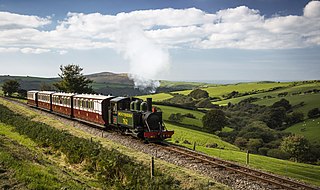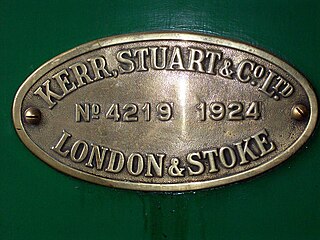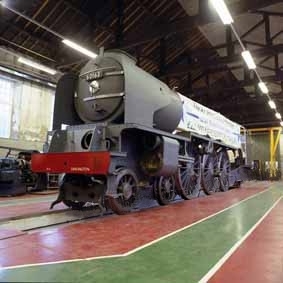
The Bure Valley Railway is a 15 in minimum gauge visitors' attraction in Norfolk, England. It was created on the original disused full-gauge bed of a defunct passenger service to incorporate a new, adjacent pedestrian footpath.

The Ravenglass and Eskdale Railway is a 15 in minimum gauge heritage railway in Cumbria, England. The 7-mile (11.3 km) line runs from Ravenglass to Dalegarth Station near Boot in the valley of Eskdale, in the Lake District. At Ravenglass the line ends at Ravenglass railway station on the Cumbrian Coast Line.

A Mallet locomotive is a type of compound articulated steam locomotive, invented by the Swiss engineer Anatole Mallet (1837–1919).
The War Department Light Railways were a system of narrow gauge trench railways run by the British War Department in World War I. Light railways made an important contribution to the Allied war effort in the First World War, and were used for the supply of ammunition and stores, the transport of troops and the evacuation of the wounded.

The Lynton and Barnstaple Railway (L&B) was a single track, 1 ft 11+1⁄2 in narrow gauge railway. It opened in May 1898 and ran for slightly more than 19 miles (31 km) through the area bordering Exmoor in North Devon, England. Although it opened after the Light Railways Act 1896 came into force, it was authorised and constructed before that act. It was authorised under its own Act of Parliament and built to higher standards than similar railways of the time. It was notable as the only narrow gauge railway in Britain that was required to use main-line standard signalling. For a short period, it earned a modest return for shareholders, but for most of its existence it made a loss. In 1923, the L&B was taken over by the Southern Railway, and eventually closed in September 1935.
Indian Railways operates India's railway system and comes under the purview of the Ministry of Railways of Government of India. As of 2023, it maintains over 108,706 km (67,547 mi) of tracks and operates over 13,000 trains daily with a fleet of 14,800 locomotives. The railways primarily operates a fleet of electric and diesel locomotives along with a few compressed natural gas (CNG) locomotives. Steam locomotives are operated on mountain railways and on heritage trains.

Kerr, Stuart and Company Ltd was a locomotive manufacturer in Stoke-on-Trent, England.

Russell is a narrow gauge steam locomotive originally built in 1906 for the North Wales Narrow Gauge Railways (NWNGR), but most famously associated with the original Welsh Highland Railway (WHR), and now based at the Welsh Highland Heritage Railway in Porthmadog.

Alan Keef Ltd is a British narrow gauge railway engineering company which manufactures, overhauls, and deals in narrow gauge locomotives, rolling stock and associated equipment.

The Kalka–Shimla Railway is a 2 ft 6 in narrow-gauge railway in North India which traverses a mostly mountainous route from Kalka to Shimla. It is known for dramatic views of the hills and surrounding villages. The railway was built under the direction of Herbert Septimus Harington between 1898 and 1903 to connect Shimla, the summer capital of India during the British Raj, with the rest of the Indian rail system.

The Railway Museum at Mysore, India is an outdoor exhibit of vintage locomotives.

The Baldwin Class 10-12-D was a class of narrow gauge 4-6-0PT steam locomotives built by the Baldwin Locomotive Works (USA) for the British War Department Light Railways for service in France during World War I. They were built in 1916–1917 to 600 mm gauge.

The Taff Vale Railway A class was a class of 0-6-2T steam tank locomotives designed by J. Cameron for mixed traffic work and introduced to the Taff Vale Railway (TVR) in 1914. The A class was an enlarged version of the TVR O4 class designed by Tom Hurry Riches in 1907. The A class was the last new class of locomotive to be introduced on the TVR, which had introduced its first 0-6-2Ts in 1885 ; and, with a total of 58 built, was numerically the largest class of tank locomotive on the TVR.

The Rhiw Valley Light Railway was a 15 in gauge railway located near to the village of Berriew in Powys, Wales. It closed on 2 October 2022.

The Dresden park railway is a 381 mm minimum gauge railway in Dresden, Germany. The line opened in 1950 and was previously known as the Kindereisenbahn and the Pioniereisenbahn. As these names suggest, the line is largely operated by children, and is a survivor of the many children's railways that were built in the former Eastern Bloc countries. The railway operates within the Großer Garten, a large city centre park.

Yeo was one of three narrow gauge 2-6-2T steam locomotives built by Manning Wardle in 1898 for the Lynton and Barnstaple Railway. The other two locomotives were named Exe and Taw. Yeo, like all the locomotives on the L&B, was named after a local river with a three-letter name, in this case the River Yeo.

Despite the advent of electric and diesel locomotives in the mid-20th century, steam locomotives continued to be used and constructed into the 21st century.
















